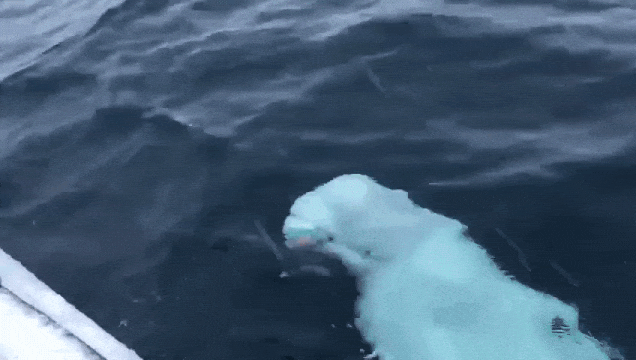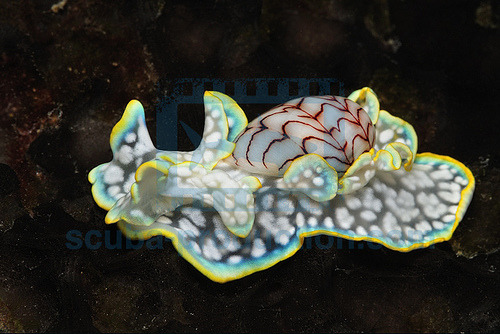Behold The Blue Glaucus (Glaucus Atlanticus), A Tiny Sea Slug That Packs A Powerful Punch! Growing Only

Behold the blue glaucus (Glaucus atlanticus), a tiny sea slug that packs a powerful punch! Growing only about 1.2 in (3 cm) long, it’s also known as the blue dragon, and it specializes in eating venomous siphonophores—like the Portuguese man o' war. It then repurposes the toxic chemicals from its prey as a defense for itself. The blue glaucus’ sting has been known to induce nausea, vomiting, and agonizing pain. Their venom can remain active even after death!
Photo: drmattnimbs, CC BY-NC 4.0, iNaturalist
More Posts from Simplyphytoplankton and Others

Sharks – like this sandbar shark in Flower Garden Banks National Marine Sanctuary – have several adaptations that make them excellent predators.
Specialized organs called ampullae of Lorenzini help sharks sense electric fields in the water generated by other fish. Their eyes, too, are specially adapted: all shark eyes have a tapetum lucidum, a layer of mirrored crystals located behind the retina, allowing them to see in in low light conditions and up to ten times better than humans in clear water.
Despite these adaptations, sandbar sharks and other sharks typically pose little threat to humans. We’re more dangerous to them than they are to us!
(Photo: Nick Zachar/NOAA)
[Image description: A black-and-white photo of a sandbar shark.]
NSF cancels grant reviews due to WH executive order
The National Science Foundation (NSF)—the major funding agency for basic science—has canceled all grant review panels this week to comply with an executive order from the new administration. This is where independent panels of scientists discuss grant proposals they’ve reviewed for scientific merit and recommend which projects get funded to NSF project managers. A LOT of work goes into setting up and scheduling grant reviews. It will take time to reschedule these panels, delaying key decisions for many promising projects. This will wreak havoc on science grant funding for months to come.
Put simply, this action along with the halting of NIH-funded grants are blatant and reckless political attacks on science, from an administration that seeks blinding loyalty.

Every once in a while, sanctuary researchers get a treat – like getting to see this tiny baby octopus! 🐙 .
Each summer, researchers conduct expeditions in our West Coast sanctuaries as part of the ACCESS conservation partnership. Researchers get to see creatures big and small when conducting surveys in places like Greater Farallones National Marine Sanctuary!

Friendly Beluga Whale Plays Fetch With Crew of a South African Ship Using a 2019 Rugby World Cup Ball
Pyrosome passing through #ClearAPathPeople
Pyrosomes are colonial tunicates made up of thousands of individuals known as zooids. Each zooid is housed in the common gelatinous tunic that makes up the larger cylindrical “body” of the pyrosome. Zooids filter phytoplankton through branchial baskets by creating feeding currents through the tunic. Although each zooid is only a couple of millimeters in size, pyrosomes can reach up to several meters in length. While alive, these organisms spend the majority of their time in the upper water column, but their remains have been found as deep as 4,000 meters (13,120 feet), where they provide food for a variety of deep-sea animals.
Pyrosomes are bioluminescent, producing brilliant blue-green light. Each zooid can detect light and emit light in response, creating waves of bioluminescence up and down the organism’s body. The bioluminescence of one pyrosome can trigger others in surrounding waters, producing beautiful light shows. The name Pyrosoma comes from the Greek term meaning “fire body.”
What’s a whale fall?






Whale falls can be found throughout the ocean. This one was spotted in Channel Islands National Marine Sanctuary, off the coast of Southern California!
GIF transcript beneath the cut.
Keep reading




North Cascades National Park, Washington
A night in the Cascade Mountains

To post about the miniature melo (Micromelo undatus) may seem a bit odd, as it is not a nudibranch but a closely-related sea snail! Its thinly-calcified shell is easily seen covering half of its back and is patterned with dazzling brown-red lines, a stark contrast to the blue, white-spotted body below. It lives in many tropic waters, whether that be Japan or Florida, and reaches about 3cm in length. It eats polychaete worms, and uses their toxins as its own.
Meet “the sheep of the Mesozoic,” Protoceratops andrewsi. This herbivore was a very common animal and is remarkably well-represented in the fossil record.

Common Dolphin, West Ireland
-
 doppelbangin liked this · 2 weeks ago
doppelbangin liked this · 2 weeks ago -
 grimark reblogged this · 2 weeks ago
grimark reblogged this · 2 weeks ago -
 newlymoultedcrab reblogged this · 2 weeks ago
newlymoultedcrab reblogged this · 2 weeks ago -
 bmetal16 liked this · 2 weeks ago
bmetal16 liked this · 2 weeks ago -
 flyingincircles liked this · 1 month ago
flyingincircles liked this · 1 month ago -
 dreamthieflynch reblogged this · 1 month ago
dreamthieflynch reblogged this · 1 month ago -
 dreamthieflynch liked this · 1 month ago
dreamthieflynch liked this · 1 month ago -
 always-thesea reblogged this · 1 month ago
always-thesea reblogged this · 1 month ago -
 ajosemariafan liked this · 1 month ago
ajosemariafan liked this · 1 month ago -
 purplecyborgnewt reblogged this · 1 month ago
purplecyborgnewt reblogged this · 1 month ago -
 stufftomakemymomsmile reblogged this · 1 month ago
stufftomakemymomsmile reblogged this · 1 month ago -
 elcinhayat liked this · 1 month ago
elcinhayat liked this · 1 month ago -
 purple-ascension liked this · 1 month ago
purple-ascension liked this · 1 month ago -
 thecrystallinehorror liked this · 1 month ago
thecrystallinehorror liked this · 1 month ago -
 waterviolite reblogged this · 2 months ago
waterviolite reblogged this · 2 months ago -
 mountainheights reblogged this · 2 months ago
mountainheights reblogged this · 2 months ago -
 halfahundredcats liked this · 2 months ago
halfahundredcats liked this · 2 months ago -
 eunyisadoran reblogged this · 2 months ago
eunyisadoran reblogged this · 2 months ago -
 anthropologicalhands reblogged this · 2 months ago
anthropologicalhands reblogged this · 2 months ago -
 larata78 liked this · 2 months ago
larata78 liked this · 2 months ago -
 subjectivemortality liked this · 2 months ago
subjectivemortality liked this · 2 months ago -
 avangelical reblogged this · 2 months ago
avangelical reblogged this · 2 months ago -
 gryphrp liked this · 2 months ago
gryphrp liked this · 2 months ago -
 thepaleosaur liked this · 2 months ago
thepaleosaur liked this · 2 months ago -
 flinngunnwestsnake liked this · 2 months ago
flinngunnwestsnake liked this · 2 months ago -
 bluph1re liked this · 2 months ago
bluph1re liked this · 2 months ago -
 vinocean22 reblogged this · 2 months ago
vinocean22 reblogged this · 2 months ago -
 gwensroses liked this · 2 months ago
gwensroses liked this · 2 months ago -
 lovely-lil-gay reblogged this · 2 months ago
lovely-lil-gay reblogged this · 2 months ago -
 jkstiles1968 liked this · 2 months ago
jkstiles1968 liked this · 2 months ago -
 narayananhariharan liked this · 2 months ago
narayananhariharan liked this · 2 months ago -
 aflockofducks reblogged this · 2 months ago
aflockofducks reblogged this · 2 months ago -
 immortalclarareborn liked this · 2 months ago
immortalclarareborn liked this · 2 months ago -
 seanpgilroy reblogged this · 2 months ago
seanpgilroy reblogged this · 2 months ago -
 therealmoogler liked this · 2 months ago
therealmoogler liked this · 2 months ago -
 blackestglass reblogged this · 2 months ago
blackestglass reblogged this · 2 months ago -
 archarmadillo reblogged this · 2 months ago
archarmadillo reblogged this · 2 months ago -
 thevagabondexpress reblogged this · 2 months ago
thevagabondexpress reblogged this · 2 months ago -
 ambulocetidae reblogged this · 2 months ago
ambulocetidae reblogged this · 2 months ago -
 siriusdigital liked this · 2 months ago
siriusdigital liked this · 2 months ago -
 ribaldotter reblogged this · 2 months ago
ribaldotter reblogged this · 2 months ago -
 ribaldotter liked this · 2 months ago
ribaldotter liked this · 2 months ago -
 angelicarosethorn liked this · 2 months ago
angelicarosethorn liked this · 2 months ago -
 poirolivia liked this · 2 months ago
poirolivia liked this · 2 months ago -
 olivepeasant liked this · 2 months ago
olivepeasant liked this · 2 months ago

Blog dedicted to phytoplankton. Phytoplankton are microscopic organisms that are responsible for half of the photosynthesis that occurs on Earth. Oh, and they look like art... Follow to learn more about these amazing litter critters! Caution: Will share other ocean science posts!Run by an oceanographer and phytoplankton expert. Currently a postdoctoral researcher.Profile image: False Colored SEM image of Emiliania huxleyi, a coccolithophore, and the subject of my doctoral work. Credit: Steve Gschmeissner/ Science Photo Library/ Getty ImagesHeader image: Satellite image of a phytoplankton bloom off the Alaskan Coast, in the Chukchi SeaCredit: NASA image by Norman Kuring/NASA's Ocean Color Web https://earthobservatory.nasa.gov/images/92412/churning-in-the-chukchi-sea
158 posts